Designing a cement processing plant is a complex task that involves multiple stages and considerations. Here’s a detailed breakdown of the process:
1. Site Selection and Feasibility Study
- Location: Choose a site with proximity to raw materials (limestone, clay, etc.), transportation facilities (roads, railways, ports), and utilities (water, electricity).
- Environmental Impact: Conduct an Environmental Impact Assessment (EIA) to understand the potential environmental effects and obtain necessary clearances.
- Market Analysis: Assess the demand for cement in the region to ensure the plant's viability.
2. Raw Material Extraction and Preparation
- Quarrying: Extract limestone and other raw materials from quarries. This involves drilling, blasting, and transporting the materials to the plant.
- Crushing: Crush the raw materials to reduce their size for further processing.
3. Raw Material Grinding
- Raw Mill: Use a raw mill to grind the raw materials into a fine powder. This can be done using ball mills, vertical roller mills, or other grinding technologies.
- Blending: Blend the ground materials to achieve the desired chemical composition.
4. Preheating and Precalcining
- Preheater Tower: Use a preheater tower to heat the raw meal using hot gases from the kiln. This reduces the energy required for the subsequent calcination process.
- Precalciner: In some plants, a precalciner is used to further heat the raw meal before it enters the kiln.
5. Clinker Production
- Rotary Kiln: The heart of the cement plant, where the raw meal is heated to around 1450°C to form clinker. The kiln is a long, rotating cylinder lined with refractory bricks.
- Cooling: Rapidly cool the clinker using air to stabilize its properties and prepare it for grinding.
6. Cement Grinding
- Cement Mill: Grind the clinker with gypsum and other additives to produce cement. This can be done using ball mills, vertical roller mills, or other grinding technologies.
- Blending and Storage: Store the ground cement in silos and blend it to ensure uniform quality.
7. Packaging and Dispatch
- Packing Plant: Pack the cement into bags or bulk containers for distribution.
- Logistics: Arrange for the transportation of the cement to customers via trucks, trains, or ships.
8. Quality Control
- Laboratory Testing: Regularly test the raw materials, clinker, and cement to ensure they meet quality standards.
- Process Control: Use automated control systems to monitor and adjust the production process in real-time.
9. Environmental and Safety Considerations
- Dust Control: Implement dust collection systems to minimize emissions.
- Waste Management: Properly manage and dispose of waste materials.
- Safety Protocols: Ensure the plant complies with safety regulations and provides a safe working environment for employees.
10. Sustainability Initiatives
- Alternative Fuels: Use alternative fuels (e.g., waste materials, biomass) to reduce reliance on fossil fuels.
- Energy Efficiency: Implement energy-efficient technologies and practices to reduce energy consumption.
- Carbon Capture: Explore carbon capture and storage (CCS) technologies to reduce CO2 emissions.
Conclusion
Designing a cement processing plant requires careful planning and consideration of various factors, including site selection, raw material preparation, clinker production, cement grinding, packaging, quality control, environmental impact, and sustainability. By addressing these aspects comprehensively, you can ensure the efficient and sustainable operation of the plant.

